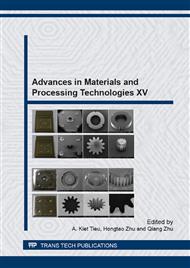p.319
p.325
p.339
p.348
p.355
p.365
p.370
p.377
p.392
Development of Data Acquisition System for Examination of Grinding Performance
Abstract:
In this paper, a data acquisition system was constructed for examining grinding performance of a plunge grinding machine. The system is capable of simultaneously recording power assumption of main spindle, grinding normal force, and material removal of a workpiece. Through grinding experiments for cylindrical workpieces, parameters of grinding process including normal force, power consumption, and time history of diametric error were obtained. With the obtained parameters, the stiffness and time constant of the grinding system were being derived such that the performance of the grinding machine was well evaluated. The configured system described in this paper can be applied to improve grinding performance through further online compensation process.
Info:
Periodical:
Pages:
355-364
Citation:
Online since:
November 2013
Authors:
Price:
Сopyright:
© 2014 Trans Tech Publications Ltd. All Rights Reserved
Share:
Citation:


